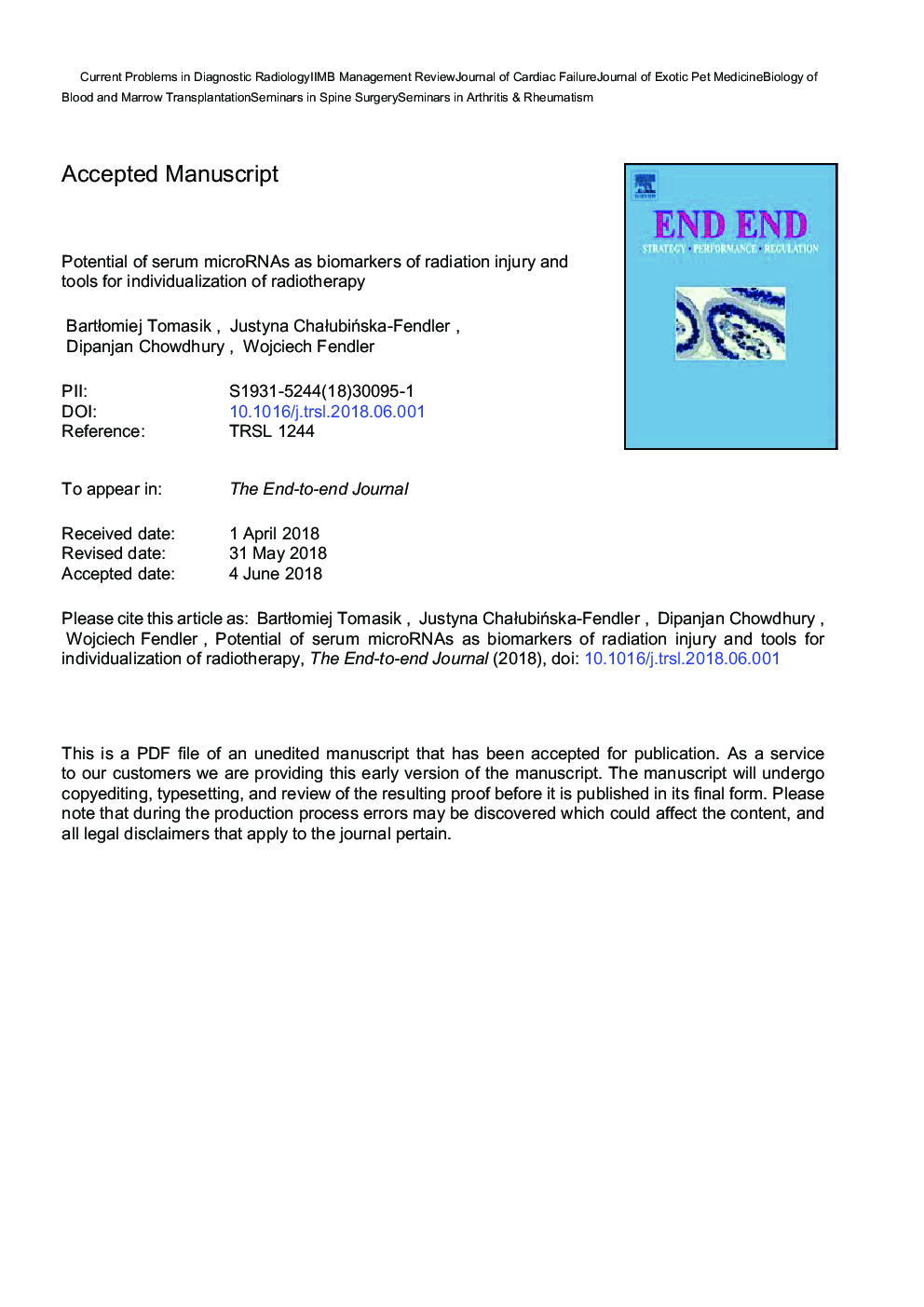| کد مقاله | کد نشریه | سال انتشار | مقاله انگلیسی | نسخه تمام متن |
|---|---|---|---|---|
| 11014012 | 1794868 | 2018 | 25 صفحه PDF | دانلود رایگان |
عنوان انگلیسی مقاله ISI
Potential of serum microRNAs as biomarkers of radiation injury and tools for individualization of radiotherapy
دانلود مقاله + سفارش ترجمه
دانلود مقاله ISI انگلیسی
رایگان برای ایرانیان
کلمات کلیدی
MIPLSFCTCAESOMAEORTCNtcpICRPRTOGHDLpri-miRNARNaseQUANTECMCPNPM1DSBDVHTRBPTGF-βPrimary miRNA - miRNA اولیهSmall interfering RNA - RNA تداخل کوچکROS - ROSsiRNA - siRNANormal tissue complication probability - احتمال عوارض بافت طبیعیribonucleic acid - اسید ریبونوکلئیکRNA - اسید ریبونوکلئیکinterleukin - اینترلوکینionizing radiation - تابش یوننده یا پرتوهای یونیزانTransforming Growth Factor Beta - تبدیل بتا فاکتور رشدLeast absolute shrinkage and selection operator - حداقل اپراتور انقباض و انتخاب مطلقRISC - خطرDrosha - درشاDicer - دیکرRadiotherapy - رادیوتراپیribonuclease - ریبونوکلئازdouble strand breaks - شکست دو رشتهLate side effects - عوارض جانبی بعدیhigh density lipoprotein - لیپوپروتئین با چگالی بالاRNA-Induced Silencing Complex - مجتمع خاموش کننده RNA inducedRadiation-induced lung toxicity - مسمومیت ریه ناشی از اشعهgenome wide association studies - مطالعات ارتباط گسترده ژنومGWAS - مطالعهٔ همخوانی سراسر ژنومMiRNA - میکروRNA، ریزآرانای، miRNADose-volume histogram - هیستوگرام حجم دوزRadiation pneumonitis - پرتوهای پنومونیmonocyte chemoattractant protein 1 - پروتئین cheoattractant monocyte 1macrophage inflammatory protein - پروتئین التهابی ماکروفاژArgonaute proteins - پروتئین های آرگونوتSingle nucleotide polymorphism - پلیمورفیسم تک نوکلئوتیدیpre-miRNA - پیش از miRNASNP - چندریختی تک-نوکلئوتیدLASSO - کمندInternational Commission on Radiological Protection - کمیسیون بین المللی حفاظت رادیولوژیکRadiation Therapy Oncology Group - گروه رادیوتراپی OncologyReactive oxygen species - گونههای فعال اکسیژن
موضوعات مرتبط
علوم پزشکی و سلامت
پزشکی و دندانپزشکی
پزشکی و دندانپزشکی (عمومی)
پیش نمایش صفحه اول مقاله

چکیده انگلیسی
Due to tremendous technological advances, radiation oncologists are now capable of personalized treatment plans and deliver the dose in a highly precise manner. However, a crucial challenge is how to escalate radiation doses to cancer cells while reducing damage to surrounding healthy tissues. This determines the probability of achieving therapeutic success whilst safeguarding patients from complications. The current dose constraints rely on observational data. Therefore, incidental toxicity observed in a minority of patients limits the admissible dose thresholds for the whole population, theoretically narrowing down the curative potential of radiotherapy. Future tools for measurements of individual's radiosensitivity before and during treatment would allow proper treatment personalization. Variation in tissue tolerance is at least partially genetically-determined and recent progress in the field of molecular biology raises the possibility that novel assays will allow to predict the response to ionizing radiation. Recently, microRNAs have garnered interest as stable biomarkers of tumor radiation response and normal-tissue toxicity. Preclinical studies in mice and nonhuman primates have shown that serum circulating microRNAs can be used to accurately distinguish pre- and postirradiation states and predict the biological impact of high-dose irradiation. First reports from human studies are also encouraging, however biology-driven precision radiation oncology, which tailors treatment to individual patient's needs, still remains to be translated into clinical studies. In this review, we summarize current knowledge about the potential of serum microRNAs as biodosimeters and biomarkers for radiation injury to lung and hematopoietic cells.
ناشر
Database: Elsevier - ScienceDirect (ساینس دایرکت)
Journal: Translational Research - Volume 201, November 2018, Pages 71-83
Journal: Translational Research - Volume 201, November 2018, Pages 71-83
نویسندگان
BartÅomiej Tomasik, Justyna ChaÅubiÅska-Fendler, Dipanjan Chowdhury, Wojciech Fendler,